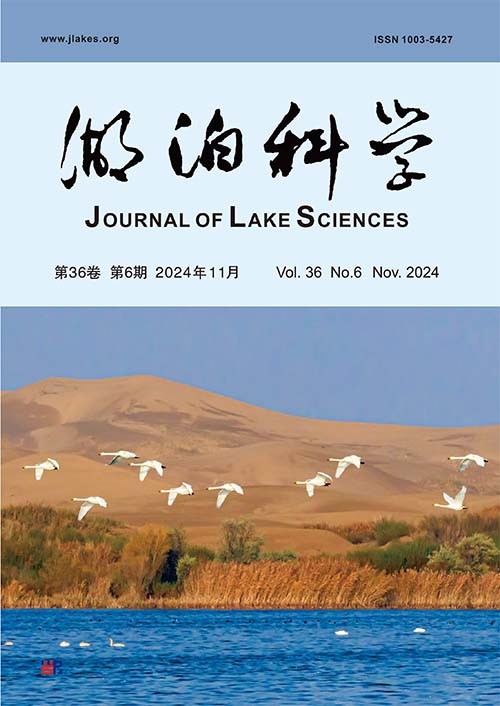Appling cyanophage to lyse cyanobacterium—Taking the infection of <i>Anabaena</i> sp. PCC 7120 by cyanophage A-4 (L) as an example
Q2 Earth and Planetary Sciences
引用次数: 0
Abstract
噬藻体在蓝藻水华发生后期快速增殖被认为是蓝藻水华消亡的重要途径,但有关噬藻体的应用却鲜有报道。本研究以噬藻体A-4(L)侵染鱼腥藻PCC 7120为例,开展光照、温度和感染复数影响噬藻体裂解藻细胞的探究,推定噬藻体在裂解蓝藻应用中的最佳投放时间及投放剂量。结果显示,光照是影响噬藻体裂解藻细胞最关键的因子,A-4(L)在全光照条件下且感染复数为0.01时,8 h即可快速裂解鱼腥藻PCC 7120,但在全黑暗条件下无裂解;光照时长越长,A-4(L)对藻细胞的裂解越快。进一步研究发现,A-4(L)在藻细胞表面的吸附不依赖光照,但在黑暗条件下A-4(L)在藻细胞内的复制受到抑制,推测A-4(L)的复制可能与宿主的光合作用有关。在15~25℃范围内,提高温度会加快A-4(L)裂解藻细胞的速度,且胞外A-4(L)效价随着温度升高而增加。在10-6~1范围内,感染复数每提高两个数量级,A-4(L)裂解藻细胞则提前4 h。综合上述结果,在7:00向湖水样品中投加感染复数为0.01的噬藻体可使PCC 7120藻细胞生物量在24 h内大幅度降低76%。本研究为蓝藻水华发生时投加噬藻体控制蓝藻种群密度提供一定基础。;Cyanophage can proliferate rapidly in the late stages of cyanobacterial blooms. Cyanophage lysis of cyanobacteria has been considered an important pathway that can induce cyanobacterial apoptosis. However, few reports have focused on the use of cyanophages. In this study, the infection of Anabaena sp. PCC 7120 by cyanophage A-4(L) was used as an example to investigate the influence of illumination, temperature and multiplicity of infection on cyanophage lysis, which can help us to determine the best timing and concentration of cyanophage addition. Our results showed that illumination was a key factor affecting cell lysis. A-4(L) lysed Anabaena sp. PCC 7120 after 8 hours at a MOI of 0.01 during continuous illumination, whereas no lysis occurred during dark incubation. In addition, prolonged illumination resulted in more rapid infection. Further studies showed that adsorption was not dependent on illumination. However, intracellular replication of cyanophage DNA was inhibited under dark conditions. It is speculated that the replication of A-4(L) DNA may be related to the photosynthesis of the host. Within the range of 15-25℃, higher temperature improved the lysis rate. The extracellular A-4(L) titer also increased with higher temperature. In the range of 10-6-1, A-4(L) lysed cells 4 h earlier when the MOI increased by two orders of magnitude. Taken together, we proposed the addition of cyanophage at a MOI of 0.01 between 7:00 and 12:00 for the purpose of bloom treatment. Further field experiments showed that the addition of cyanophage at a MOI of 0.01 at 7:00 am did indeed significantly reduce the biomass of PCC7120 algal cells by 76% within 24 hours. This study provides a basis for using cyanophages to control the abundance of cyanobacteria during cyanobacterial blooms.应用噬藻体裂解蓝藻——以Anabaena</i>以噬菌体A-4 (L)为例
噬藻体在蓝藻水华发生后期快速增殖被认为是蓝藻水华消亡的重要途径,但有关噬藻体的应用却鲜有报道。本研究以噬藻体A-4(L)侵染鱼腥藻PCC 7120为例,开展光照、温度和感染复数影响噬藻体裂解藻细胞的探究,推定噬藻体在裂解蓝藻应用中的最佳投放时间及投放剂量。结果显示,光照是影响噬藻体裂解藻细胞最关键的因子,A-4(L)在全光照条件下且感染复数为0.01时,8 h即可快速裂解鱼腥藻PCC 7120,但在全黑暗条件下无裂解;光照时长越长,A-4(L)对藻细胞的裂解越快。进一步研究发现,A-4(L)在藻细胞表面的吸附不依赖光照,但在黑暗条件下A-4(L)在藻细胞内的复制受到抑制,推测A-4(L)的复制可能与宿主的光合作用有关。在15~25℃范围内,提高温度会加快A-4(L)裂解藻细胞的速度,且胞外A-4(L)效价随着温度升高而增加。在10-6~1范围内,感染复数每提高两个数量级,A-4(L)裂解藻细胞则提前4 h。综合上述结果,在7:00向湖水样品中投加感染复数为0.01的噬藻体可使PCC 7120藻细胞生物量在24 h内大幅度降低76%。本研究为蓝藻水华发生时投加噬藻体控制蓝藻种群密度提供一定基础。;Cyanophage can proliferate rapidly in the late stages of cyanobacterial blooms. Cyanophage lysis of cyanobacteria has been considered an important pathway that can induce cyanobacterial apoptosis. However, few reports have focused on the use of cyanophages. In this study, the infection of Anabaena sp. PCC 7120 by cyanophage A-4(L) was used as an example to investigate the influence of illumination, temperature and multiplicity of infection on cyanophage lysis, which can help us to determine the best timing and concentration of cyanophage addition. Our results showed that illumination was a key factor affecting cell lysis. A-4(L) lysed Anabaena sp. PCC 7120 after 8 hours at a MOI of 0.01 during continuous illumination, whereas no lysis occurred during dark incubation. In addition, prolonged illumination resulted in more rapid infection. Further studies showed that adsorption was not dependent on illumination. However, intracellular replication of cyanophage DNA was inhibited under dark conditions. It is speculated that the replication of A-4(L) DNA may be related to the photosynthesis of the host. Within the range of 15-25℃, higher temperature improved the lysis rate. The extracellular A-4(L) titer also increased with higher temperature. In the range of 10-6-1, A-4(L) lysed cells 4 h earlier when the MOI increased by two orders of magnitude. Taken together, we proposed the addition of cyanophage at a MOI of 0.01 between 7:00 and 12:00 for the purpose of bloom treatment. Further field experiments showed that the addition of cyanophage at a MOI of 0.01 at 7:00 am did indeed significantly reduce the biomass of PCC7120 algal cells by 76% within 24 hours. This study provides a basis for using cyanophages to control the abundance of cyanobacteria during cyanobacterial blooms.
本文章由计算机程序翻译,如有差异,请以英文原文为准。
求助全文
约1分钟内获得全文
求助全文
来源期刊

湖泊科学
Environmental Science-Water Science and Technology
CiteScore
3.70
自引率
0.00%
发文量
3253
期刊介绍:
Journal of Lake Sciences (ISSN 1003-5427) was founded in 1989 and is jointly sponsored by Nanjing Institute of Geography and Lake Sciences, Chinese Academy of Sciences and Chinese Society of Oceanology and Limnology. It mainly reports the latest research results on the changes in resources, ecology and environment of lakes (including reservoirs) and their basins under the interaction between man and nature. It publishes theoretical or applied research papers, briefs and reviews on various disciplines related to lake science (such as physics, chemistry, biology, ecology, geology, geography, etc.) as well as lake engineering and integrated basin management. Since 2006, the journal has been changed to a bimonthly publication, published on January, March, May, July, September and November 6 by Science Press.
 求助内容:
求助内容: 应助结果提醒方式:
应助结果提醒方式:


